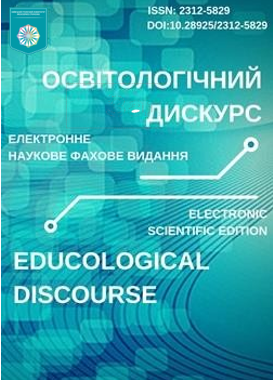The Essence and Structure of Foreign Language Professional Competence of Students of Technical Specialties
DOI:
https://doi.org/10.28925/2312-5829/2024.3.5Keywords:
subject-language integrated education, technical specialties, professional competence, foreign language communicative competenceAbstract
Abstract. The article examines the fact that in modern state standards of higher education, from a number of areas of training of students of technical specialties, mastering a foreign language is presented at once in two competences. At the same time, if previously the goal of foreign language learning in higher education institutions was the formation of foreign language communicative competence and all components in the social, everyday and sociocultural spheres of communication, then modern state standards of higher education also emphasize the formation of communicative competence in the professional sphere of communication.
It was found that such an expansion of the spheres of using a foreign language as a means of communication contributed to the designation of the formation of professional foreign language communicative competence as one of the main goals of teaching a professional foreign language to students of technical specialties. At the same time, scientists have not yet reached a consensus regarding the structure and component composition of professional foreign language communicative competence.
The history of the issue is considered, the structure and component composition of the professional foreign language communicative competence of students of technical specialties is proposed. Structurally, students' professional foreign language communicative competence includes two components: foreign language communicative and professional. Foreign language communicative consists of five sub-competencies: linguistic, language, socio-cultural, compensatory and educational-cognitive. The professional component includes knowledge in a specific field of professional activity and professional activities of specialists in a specific field of training. It has been investigated that this component will largely determine the content of training components of foreign language communicative competence, adding professionally-oriented subject content to the training process, which reflects the specialty of specialists in the technical field.
In addition, it was established that as a level category, professional foreign language communicative competence of students consists of five components: value-motivational, cognitive, operational, communicative, reflective. The content of these components is described in detail in the work.
Downloads
References
Коваленко О. Формування компетентнісного підходу до вивчення іноземних мов. Іноземні мови в навчальних закладах. 2008. № 3. С. 28–34.
Хвалибога Т.І., Паласюк М.І. Особливості і перспективи формування іншомовної комунікативної компетентності у студентів закладів вищої освіти. Медична освіта, 2023. № 4. С. 94–98. DOI: https://doi.org/10.11603/m.2414-5998.2022.4.13639
Юхно Н. Суть та структура іншомовної комунікативної компетентності фахівців. Наукові записки кафедри педагогіки. 2022. Вип. 51. С. 113–119. DOI: https://doi.org/10.26565/2074-8167-2022-51-13
Zubkov, А. Professional Foreign Language Competence of Technical Students: Content, Structure and Formation. Integrating Engineering Education and Humanities for Global Intercultural Perspectives. 2022. Pp. 503–510). https://doi.org/10.1007/978-3-030-47415-7_53
Bezukladnikov, K. E., Novosyolov, M. A., & Kruze, B. A. The international teacher’s foreign language professional communicative competency development. Procedia-Social and Behavioral Sciences, 2014, 154, 329–332. https://doi.org/10.1016/j.sbspro.2014.10.158
Hamidova, S., Ganiyeva, X. & Umarkulova, M. Development of professional competence in learning foreign languages for students of students of non-language higher education institutions. EPRA International Journal of Research and Development (IJRD), 2020, 5(1), 193–195. https://doi.org/10.36713/epra2016
Hymes, D. (1972). On Communicative Competence. In J. Pride, & J. Holmes (Eds.), Sociolinguistics (pp. 269-285). Harmondsworth: Penguin Books.
Elder, C., McNamara, T., Kim, H., Pill, J., & Sato, T. Interrogating the construct of communicative competence in language assessment contexts: What the non-language specialist can tell us. Language & Communication, 2017, 57, 14–21. https://doi.org/10.1016/j.langcom.2016.12.005
Chomsky, N. (1965). Aspects of the Theory of Syntax (50th ed.). The MIT Press. http://www.jstor.org/stable/j.ctt17kk81z
Sandal, J.-U., Detsiuk, T., & Kholiavko, N. Developing foreign language communicative competence of engineering students within university extracurricular activities. Advanced Education, 2020, 7(14), 19–28. https://doi.org/10.20535/2410-8286.192411
Vasilieva, P. Foreign language communicative competence: problems, approaches, searches and solutions. International Scientific Journal of Universities and Leadership, 2020, (9), 98–108. https://doi.org/10.31874/2520-6702-2020-9-1-98-108
Zhernovnykova, O. A, Nalyvaiko, О. О., Nalyvaiko, N. A. Formation of information and digital competence of future teachers in the context of the development of the New Ukrainian School: monograph “Theory and practice of introduction of competence approach to higher education in Ukraine” edit. I. M. Trubavina, S. T. Zolotukhina. Vienna: Premier Publishing. 2019, Р. 208–216.
Zhernovnykova, O., Kovalenko, O., Mkrtichian, O., Zelenska, L. Evaluation of the professional teaching competence: chinese experience. Journal of Education, Health and Sport, 2020, 10(3), 199–207. https://zenodo.org/ record/3757294
Published
How to Cite
Issue
Section
License
Copyright (c) 2024 Educological discourse

This work is licensed under a Creative Commons Attribution-NonCommercial 4.0 International License.
Автори зберігають за собою всі авторські права та одночасно надають журналу право першої публікації на умовах лізенції Creative Commons Attribution-NonCommercial-ShareAlike 3.0 Unported License, що дозволяє розповсюджувати даний матеріал із зазначенням авторства та первинної публікації в даному журналі.





















